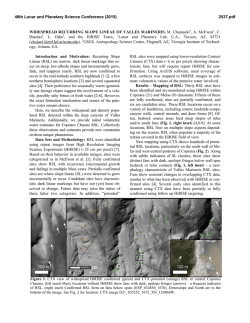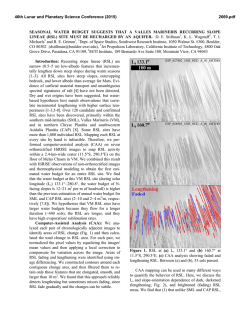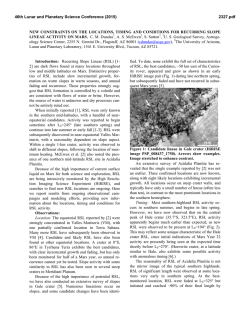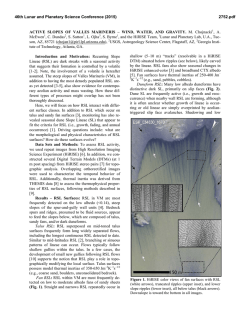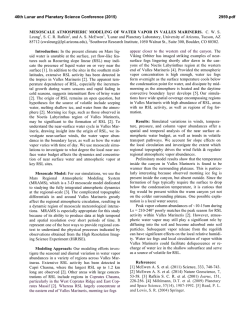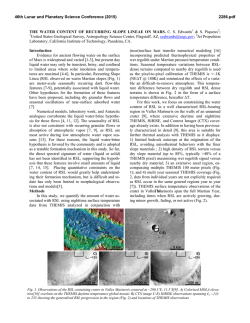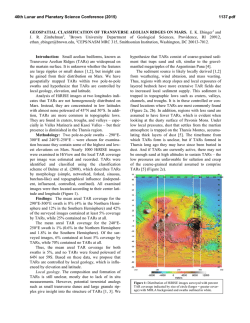
QUANTIFYING THE BEHAVIOR OF RECURRING SLOPE LINEAE
46th Lunar and Planetary Science Conference (2015) 2930.pdf QUANTIFYING THE BEHAVIOR OF RECURRING SLOPE LINEAE (RSL). E. I. Schaefer1, A. S. McEwen1, S. Mattson1, and L. Ojha2, 1Lunar and Planetary Laboratory, University of Arizona, Tucson, AZ 85721 ([email protected]), 2School of Earth and Atmospheric Sciences, Georgia Institute of Technology, Atlanta, GA 30332-0340. Introduction: Recurring slope lineae (RSL) are narrow (0.5-5 m) linear features on Mars that initiate and grow downslope on steep (25-40°), rocky slopes, primarily in the southern midlatitudes and in the tropics near Valles Marineris [1,2]. The hypothesis that they are due to flow of brine or liquid water at or very near the surface is suggested by their exclusive occurrence in places and at times where afternoon brightness temperatures reach ~250-300 K [2,3] as measured by the Thermal Emission Imaging System [4], their rapid fading when winter approaches, and their flow-like morphology [1,2]. Unlike classical slope streaks [1], RSL continue to grow over timescales of weeks and recur in multiple years at the same location, a “life cycle” that is more consistent with a “wet” than a “dry” mechanism. Nonetheless, a source for liquid water is unclear [3] and the volume that would be involved is likely substantial [5]. In this study, we therefore remain agnostic as to the formation mechanism. Instead, we are quantifying the life cycle of RSL in as much spatial and temporal detail as possible for the first time, using imagery from the High Resolution Imaging Science Experiment (HiRISE) [6] and elevations derived therefrom. Our ultimate goal is to determine with what mechanism or mechanisms the detailed behavior of RSL is most consistent. The measurements from the current study will contribute to this goal by providing necessary constraints to proposed RSL mechanisms as these are explored via laboratory work [e.g., 7,8], modeling [e.g., 5], and terrestrial analogs [e.g., 9]. Methods: We are currently focusing on Tivat crater in the southern midlatitudes (Noachis Terra) but will expand the study to other sites. We have generated a high-resolution Digital Terrain Model (DTM) [10] from HiRISE images ESP_012991_1335 and ESP_013624_1335 and have coregistered and orthorectified all 20 HiRISE images of the site to this DTM. We are also actively acquiring new HiRISE images for the ongoing active season. Mapping RSL presents several complications chiefly stemming from their small size—near the HiRISE resolution limit—and their unknown origin—which hampers geologic inference. To accurately represent this ambiguity, we collect ancillary data while mapping RSL (Fig. 1) so that we can later simulate different plausible interpretations of their extents and interimage behavior. This in turn will allow us to quantify the influence of specific assumptions and assess the limitations of our measurements. For enhanced efficiency, reproducibility, and consistency, we are using automated algorithms wherever possible to process the mapped polygons, including conversion of these polygons to linear representations (“skeletons”) via an adaptation of the medial axis transform [11]. This conversion allows us to make linear measurements such as length and growth rate. Results: The algorithm to simulate different plausible interpretations is currently in development. However, using the most liberal interpretation, select results are complete. In MY 30, at Ls 250.6, no RSL are observed, but 13 RSL form and grow to an average length of ~55 m by 11 sols later (Ls 257.8), an “inter-image growth rate” of ~5 m/sol (Table 1). By 32 sols later (Ls 278.5), 93 new RSL have formed but their inter-image growth rate over this longer interval is ~1 m/sol. Also, only 5 of the earlier RSL continue to grow during the interval, at an inter-image rate of ~3 m/sol. For the three longest RSL at Tivat crater, we have completed mapping for the entire Mars Year (MY) 30 active season. The results indicate that the initial growth rate of these RSL is very rapid and continues at a progressively slower pace for several weeks (Fig. 1). They also reveal that these RSL maintain a very nearly constant slope along their lengths (Fig. 2) despite the concavity of the crater wall that hosts them. Discussion: The sample RSL life cycles (Fig. 1) suggest that RSL grow fastest early in their life cycles. Qualitative observations suggest that this behavior is general, a conclusion that is further supported by the severe drop in inter-image growth rate of new RSL from 5 m/sol when the inter-image interval is 11 sols to ~1 m/sol for the next inter-image interval of 32 sols. There are also hints in the current data that RSL that form earlier in the season grow faster, but this inference should be considered tentative as it is based on relatively few data. A robust conclusion (earlier suggested by [2]) is that RSL are supply-controlled, as their ending slopes are very similar to their starting slopes. Indeed, many RSL at Tivat have nearly linear longitudinal topographic profiles (Fig. 2), in part because sinuosity decreases away from the head. In essence, RSL at Tivat create their own switchbacks. 46th Lunar and Planetary Science Conference (2015) 2930.pdf It should be noted that even though growth rate slows as RSL evolve, this does not imply that flow rate must decrease if RSL are wet. It may be that sustained or even enhanced flow is necessary to offset evaporation and extend the RSL after an initial length is established (as discussed by [5]). More generally, directly inferring process from even careful quantification of form is problematic. This degeneracy highlights the need for the planned modeling study, which will use the detailed observations from the current study as constraints. Acknowledgements: This material is based in part on work supported by the National Science Foundation Graduate Research Fellowship under Grant No. 2012116373. References: [1] Ojha L. et al. (2011) LPSC 42, Abstract #2101. [2] McEwen A. S. et al. (2011) Science, 333, 740-743. [3] McEwen A. S. et al. (2014) Nature Geoscience, 7, 53-58. [4] Christensen, P. R. et al. (2004) Space Sci. Rev., 110, 85-130. [5] Grimm R. E. et al. (2014) Icarus, 233, 316-327. [6] McEwen A. S. et al. (2007) JGR, 112, E05S02. [7] Chevrier V. F. and Rivera-Valentin, E. G. (2012) Geophys. Res. Lett., 39, L21202. [8] Masse M. et al (2014) Planet. Space Sci., 92, 136-149. [9] Levy, J.S. (2012) Icarus, 219, 14. [10] Kirk R. L. et al. (2008) JGR, 113, E00A24. [11] .T. W. Brandt and V. H. Algazi (1992) CVGIP: Image Understanding, 55, 329-337. Table 1 MY 29 MY 30 6 Ls 290.3 Ls 250.6 Ls 257.8 Ls 278.5 Sol (Fig. 1) N/A -5.5 5.5 37.5 # of RSL 98 0 18 108 2 total areal extent (m ) total length along 1 surface (m) mean all RSL: median all RSL: growth rate (m/sol) mean all RSL: mean extended3 RSL: 3 median extended RSL: 4 mean inherited RSL: mean new5 RSL: 11,651 N/A 702 3,940 1 13,506 169 61 N/A N/A N/A 741 57 55 3,940 47 23 ---- N/A N/A N/A 5.04 --- 2 1.04 3.49 2.48 --- N/A N/A --- 1.61 1.10 values for ~90% of RSL for which centerlines were found 2 lower bound; 2x larger if estimated as in Fig. 2 3 new in Ls 257.8 image + grew in Ls 278.5 image 4 new in Ls 257.8 image 5 new in Ls 278.5 image 6 baseline image (before active season began) Fig. 1 (left). Examples of RSL life cycles from Tivat (this study) and Raga [5] in MY 30, with markers at each HiRISE image. Gray ranges are uncertainty in RSL initiation. Fig. 2 (right). Topographic profiles (no vertical exaggeration) for the same Tivat RSL as in Fig. 1, with markers at the length achieved by the time of each HiRISE image. Dashed reference lines are perfectly linear.
© Copyright 2025
